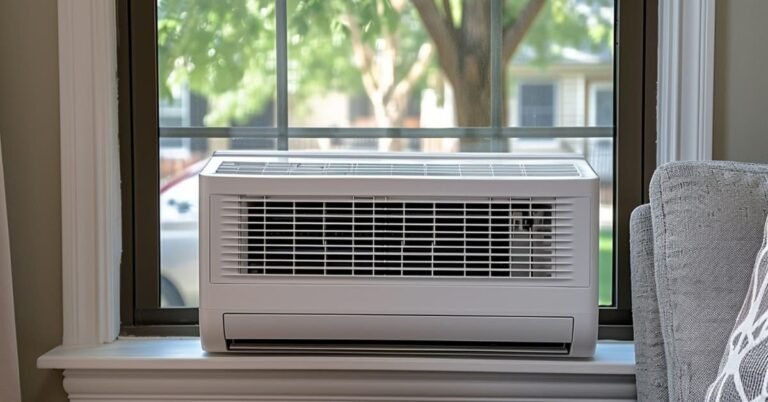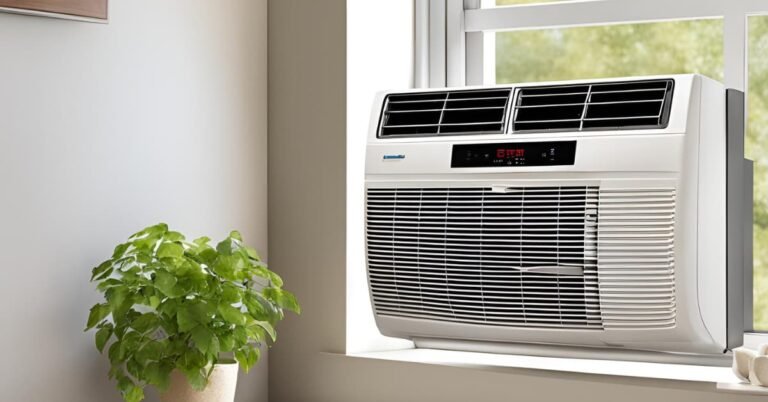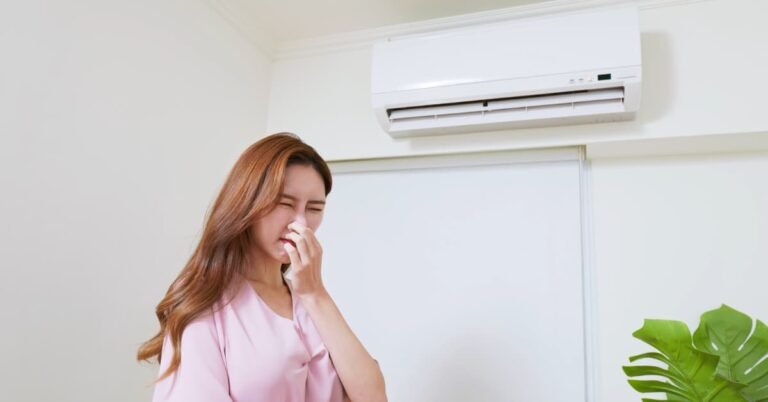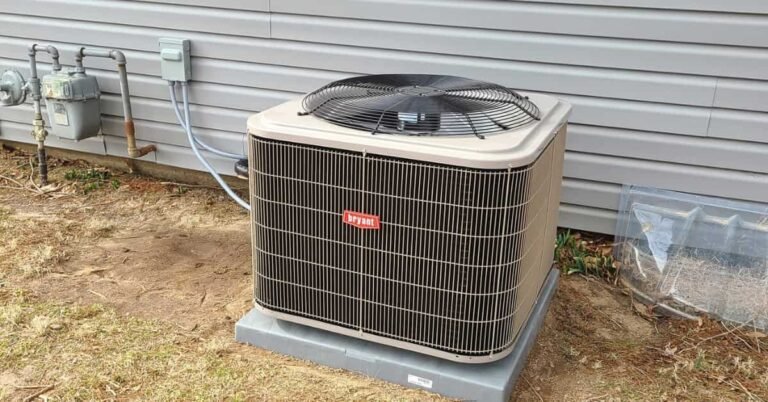LG Portable Air Conditioner Blowing Hot Air – 10 Solution
LG portable air conditioners are a popular choice for cooling small spaces. But what do you do when they start blowing hot air instead of cool?
To address and resolve this issue, it’s important to consider various contributing factors.
Our comprehensive guide will help you troubleshoot and fix the issue.
Why LG Portable Air Conditioner Blowing Hot Air?
Several factors may contribute to this issue. Let’s explore why an LG portable AC blows hot air and how to fix it.
Whether it’s compressor problems, improper installation, sensor malfunction, faulty control board, or insufficient size/power for the room, we’ll walk you through the steps to fix the problem and restore cool air in your space.
So let’s dive in and troubleshoot the issue together!

Thermostat Setting
One possible reason your LG portable air conditioner blows hot air is incorrect thermostat settings.
The thermostat controls the desired temperature. If it’s set too high or in heating mode, the unit may only circulate warm air.
How To Fix?
1. Ensure correct mode: Double-check that the thermostat is set to the cooling mode. This can typically be done by switching the unit off, then pressing the mode button until it shows “Cool” or a snowflake symbol.
2. Adjust temperature: Set the desired temperature on your AC unit’s thermostat between 68-72°F (20-22°C) for optimal cooling performance.
3. Allow time to cool: Give your portable AC some time to cool down after setting it to your preferred temperature, as it may take a few minutes for the system to reach and maintain that temperature.
4. Keep away from heat sources: Make sure there are no heat-generating appliances near the thermostat that could give false readings and cause inappropriate cooling operations.
5. Clean sensor: If you suspect a faulty thermostat reading, gently clean the sensor with a soft cloth or cotton swab to remove any dust or debris that might interfere with its accuracy.
Power Supply Issues
If an LG portable air conditioner blows hot air instead of cool air, power supply issues could be a factor.
Issues such as improper power source connections or tripped circuit breakers can disrupt the proper functioning of the appliance.
How To Fix?
1. Check power connections: Verify that your AC unit is properly plugged into a functioning power outlet. Ensure the outlet’s voltage matches the required specifications mentioned in the user manual.
2. Reset circuit breaker: If your air conditioner is not receiving power, check the circuit breaker panel and reset any tripped breakers by flipping them back to the “On” position.
3. Test with another outlet: Try plugging your portable AC into a different outlet to verify if there’s an issue with the initial power source.
4. Inspect power cord: Examine the power cord for any signs of damage or frayed wires. If any issues are detected, do not use the unit and contact a qualified technician or customer service for assistance.
5. Contact professional help: If you have tried all troubleshooting steps and your unit still experiences power supply issues, it’s recommended to consult an HVAC technician or LG customer support for further guidance.

Dirty Air Filters
A common reason for an LG portable air conditioner blowing hot air is dirty or clogged air filters.
Filthy filters restrict airflow, affecting performance and preventing proper cooling.
How To Fix?
1. Locate filter access panel: Identify and locate the filter access panel on your portable AC unit. This can typically be found on either the front or side of the device.
2. Turn off the unit: Switch off and unplug the air conditioner from its power source to ensure safety during maintenance.
3. Remove filters: Open up the filter access panel and carefully remove both washable and disposable filters from their respective compartments.
4 (A). Washable filters: If you have washable filters, rinse them gently under running water until clean. Allow them to dry completely before reinstalling them into their original positions.
4 (B). Disposable filters: For disposable filters, replace them with new ones according to the manufacturer’s instructions. Ensure proper alignment and secure placement.
5. Reinstall filters: Place the cleaned or new filters back into their respective slots, making sure they fit snugly without any gaps.
6. Regular maintenance: Clean washable filters regularly, ideally once every two weeks during periods of heavy use. Disposable filters should be replaced as recommended by the manufacturer.
Refrigerant Leaks
A refrigerant leak can cause an portable AC to blow hot air instead of cool air. Refrigerant is responsible for absorbing heat from indoors, and if there is a leak, the cooling process becomes inadequate.
How To Fix?
1. Detection: Contact an HVAC professional who is certified in handling refrigerants to assess and detect refrigerant leaks. They will use specialized equipment such as electronic leak detectors or nitrogen pressure tests.
2. Repair or replace: If a refrigerant leak is detected, depending on the severity and condition of the unit, repairs may be possible by locating and fixing the source of the leakage. In some cases, replacing the unit might be necessary.
3. Preventive measures: Regularly scheduled maintenance by professionals can help spot early signs of leaks and ensure optimal performance of your portable AC unit.
Compressor Problems
If your portable air conditioner is blowing hot air, compressor problems may be the culprit. The compressor is responsible for cooling the air and circulating it throughout the room.
If there are issues with the compressor, it can lead to inadequate cooling performance.
How To Fix?
1. Check for power supply: Ensure that the power supply to the unit is stable and not interrupted. Unplug the air conditioner and plug it back in securely.
2. Clean or replace filters: Dirty or clogged filters can put strain on the compressor and affect its performance. Clean or replace the filters according to the manufacturer’s instructions.
3. Inspect refrigerant levels: Low refrigerant levels can cause the compressor to work harder, resulting in reduced cooling capacity. Contact a professional technician to check and recharge the refrigerant if necessary.

Condenser Coils Need Cleaning
Dirty or clogged condenser coils in an LG portable AC can hinder heat exchange efficiency. This can result in poor cooling performance and cause the unit to blow hot air.
How To Fix?
1. Disconnect power: Turn off and unplug your portable AC unit from its power source before starting any cleaning procedures for safety purposes.
2. Locate condenser coils: Identify the location of your AC’s condenser coils. They are commonly found at the back of the unit or on one side (if exposed).
3. Remove debris: Using a soft brush or vacuum cleaner with a brush attachment, carefully remove any visible dust, dirt, or debris from the condenser coil surfaces.
4. Fin comb (optional): If there is excessive blockage between fins, consider using a fin comb (available at hardware stores) to gently straighten them and improve airflow.
5. Remove stubborn residue: For stubborn residue on the coil surfaces, mix a mild detergent with warm water and dampen a soft cloth or sponge. Gently scrub away the dirt without applying excessive force.
6. Rinse and dry: Rinse away any soapy residue by wiping with a damp cloth or spraying with clean water if possible. Allow sufficient time for all components to dry completely.
7. Reassemble and test: Once dry, reassemble the AC unit, ensuring all components are properly secured. Plug in and turn on the device to check if it now blows cool air as expected.
Sensor Malfunction
A malfunctioning sensor in an air conditioner can cause it to blow hot air instead of cool air.
The sensor detects the room temperature and signals the unit to adjust its cooling operations accordingly.
How To Fix?
1. Reset the unit: Turn off the air conditioner, unplug it for a few minutes, then plug it back in and turn it on again. This can reset any temporary sensor malfunctions.
2. Clean the sensor: Dust or dirt on the sensor may interfere with its accuracy. Gently clean the sensor with a soft cloth or cotton swab to remove any debris that might be affecting its readings.

Improper Installation
Improper installation of an LG portable air conditioner can lead to various operational issues, including blowing hot air.
Inadequate sealing or incorrect placement can negatively affect airflow and overall cooling efficiency.
How To Fix?
1. Window kit installation: Ensure that you have installed the window kit correctly according to the manufacturer’s instructions. It should create a secure seal between the exhaust hose and window opening.
2. Proper positioning: Place your unit near a window for efficient ventilation, while avoiding direct exposure to sunlight or other heat sources that could impact its performance.
3. Adequate insulation: Insulate any gaps around the window kit using weather stripping or foam insulation tape to prevent external warm air from entering and affecting cooling performance.
4. Check for obstructions: Ensure that there are no objects obstructing the airflow around the intake or exhaust vents of the air conditioner. Clear away any debris or obstructions as needed.
Faulty Control Board
A faulty control board in an LG portable air conditioner can disrupt its normal operation, leading it to blow hot air instead of cool air.
The control board is responsible for regulating various functions within the unit, including temperature control and fan speed.
How To Fix?
1. Power cycle the unit: Turn off the AC unit, unplug it for a few minutes, then plug it back in and turn it on again. This can sometimes reset the control board and resolve temporary issues.
2. Check for error codes: Some LG portable air conditioners have error code displays that can indicate specific problems. Refer to the user manual to identify any error codes and their corresponding troubleshooting steps.
3. Professional repair: If power cycling or troubleshooting does not solve the issue, there may be a need for professional repairs to replace or repair the faulty control board. Contact an authorized service center or technician for assistance.
Insufficient Size/Power for Room
Your LG portable AC blows hot air, it may be because the unit is too small or underpowered for the cooling requirements of the room.
Inadequate cooling capacity can lead to ineffective temperature regulation.
How To Fix?
1. Determine appropriate unit size: Use an online sizing calculator or consult a professional to determine the suitable size and cooling capacity required for your room’s square footage.
2. Upgrade to a larger unit: If your current unit does not meet the recommended capacity, consider upgrading to a higher-capacity air conditioner that better matches your room’s cooling demands.
3. Look for energy-efficient models: When upgrading, opt for energy-efficient units that provide optimal cooling performance while minimizing energy consumption.
4. Improve insulation: Ensure proper insulation in your space by sealing any gaps around windows, doors, and other openings to prevent unwanted heat from entering and affecting cooling efficiency.
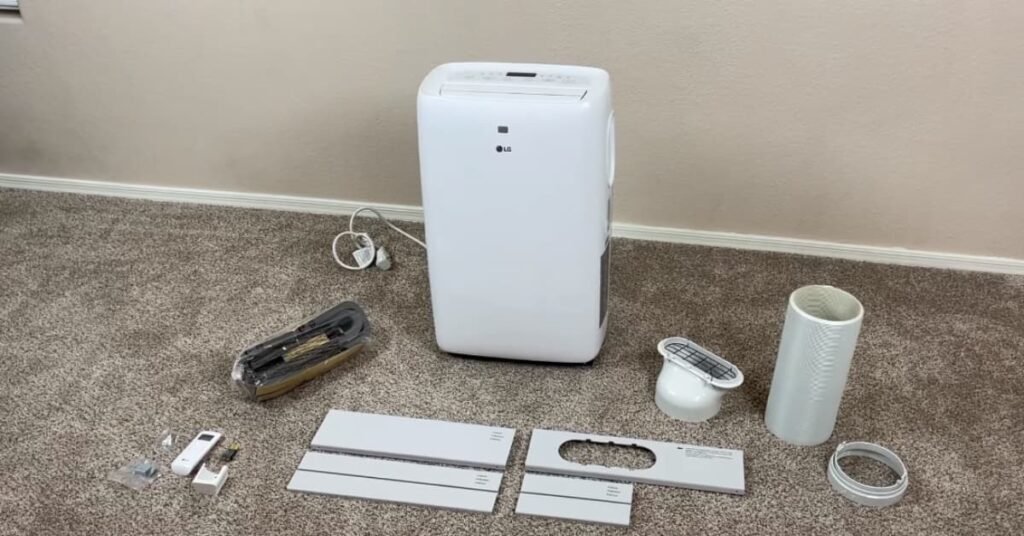
How Do I Reset My LG Portable Air Conditioner?
You may need to reset your LG portable air conditioner for a few reasons: power outage, software glitch, or restoring default settings.
Here is a step-by-step guide on how to reset your LG portable air conditioner:
- Check the power supply and ensure it is stable.
- Power off the unit and unplug it from the electrical outlet.
- Wait for a few minutes before plugging it back in.
- Press and hold the reset button for 3-5 seconds.
- Release the reset button and wait for the unit to restart.
If you’re unsure where to find the reset button, consult your user manual or reach out to LG customer support for help.
Troubleshooting Issues After The Reset
If you encounter issues after resetting your LG Portable air conditioner, here are some steps you can take:
- Check for error codes: If the unit displays an error code, refer to the manual for specific troubleshooting steps.
- Seek professional assistance: If you are unable to resolve the issue on your own, consider contacting a professional HVAC technician for further assistance.
- Contact LG customer support: You can also reach out to LG customer support for additional guidance or to schedule a service appointment.
Conclusion
When an LG portable air conditioner blows hot air, it’s crucial to identify the cause and take appropriate action.
By addressing factors such as thermostat settings, power supply issues, dirty air filters, condenser coil maintenance, refrigerant leaks, compressor problems, improper installation Etc. you can restore efficient cooling and comfort.
Whether it’s adjusting settings or performing maintenance tasks, following the provided step-by-step guides can help you diagnose and fix the issue promptly.
Don’t let hot air ruin your comfort, tackle the problem head-on with these solutions.

